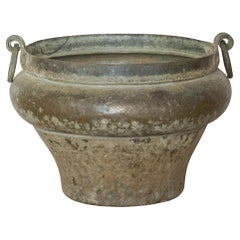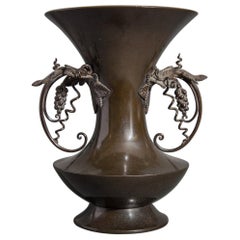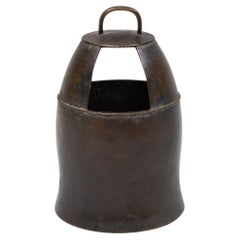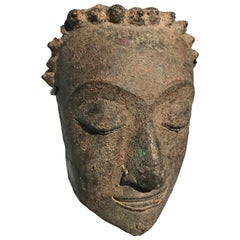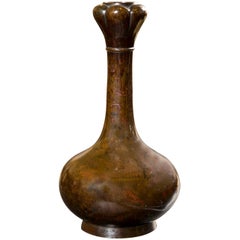Metalwork
to
293
1,053
607
1,854
22
5
89
45
25
21
11
9
7
7
4
3
1
1
1
1
126
883
845
27
441
182
56
40
12
20
8
10
8
23
10
5
1
1,847
616
376
347
340
1,543
1,135
632
460
186
1,881
1,869
1,877
17
16
15
5
4
Metalwork For Sale
Large Bronze Tibetan Vase with Handles
Located in Alessandria, Piemonte
Large Tibet bronze and copper vase with handles: exceptional and perfect.
Sizes: diameter at the top cm. 52, with handles cm. 61. Base 35 cm.
High cm. 43....
Category
Late 19th Century Tibetan Other Antique Metalwork
Materials
Bronze
Vintage Chinese Floral Cast Iron Mortar
Located in Chicago, IL
This vintage cast iron mortar from China's Shanxi province is patterned in low relief with a simple floral design. Originally used in a traditional ap...
Category
Mid-20th Century Chinese Rustic Metalwork
Materials
Iron
19th Century Superior Quality Japanese Bronze Vase with Grape Vine Handles
Located in Hudson, NY
19th century superior quality Japanese bronze vase with grape vine handles. Beautifully shaped Edo period (first half of the 19th century) vase with c...
Category
Early 19th Century Japanese Edo Antique Metalwork
Materials
Bronze
Japanese Bronze Incense Burner 'Koro'
Located in Hudson, NY
Wood storage box.
Category
18th Century Japanese Antique Metalwork
Materials
Bronze
Fragment of Bronze Head of Buddha, Thailand
Located in Schellebelle, BE
Fragment of Bronze Head of Buddha
Thailand
16th Century
Category
16th Century Thai Antique Metalwork
Materials
Bronze
Japanese Bronze Vase
Located in Stamford, CT
A Japanese patinated bronze vase of outstanding color with a lotus bud form top.
Category
19th Century Japanese Antique Metalwork
Materials
Bronze
$7,800
Group of Fourteen Japanese Meiji Period Gilt Metal Plaques
Located in London, GB
Group of fourteen Japanese Meiji period gilt metal plaques
Japanese, Late 19th Century
Height 2cm, width 2cm
These beautiful Japanese Meiji period plaque...
Category
Late 19th Century Japanese Meiji Antique Metalwork
Materials
Metal
A most unusual silver and gold leaf cloisonné vase by Sukiku, 1981
Located in Lymington, Hampshire
A most unusual silver and gold leaf cloisonné vase by Sukiku, 1981, the ovoid body decorated in abstract designs with wispy silver shapes and moriage gold leaf scattered over a mottl...
Category
1980s Japanese Vintage Metalwork
Materials
Metal, Gold, Silver
16th Century Chinese Standing Bronze Figure of a Nobleman
Located in Hudson, NY
Hongzhi Period (1487 - 1505) sculpture of an important man, possibly Confucius. Comes with box.
Category
16th Century Chinese Antique Metalwork
Materials
Bronze
Chinese Ormolu and Cloisonné Enamel Vase for the Islamic Market
Located in London, GB
Chinese Ormolu and Cloisonné enamel vase for the Islamic Market
Chinese, early 20th century
Dimensions: Height 19cm, diameter 23cm
Crafted in China...
Category
Early 20th Century Chinese Chinese Export Metalwork
Materials
Bronze, Enamel, Ormolu
Chinese Export Silver Openwork Dragon Bowl by Wang Hing & Co, Hong Kong, 1890
Located in Sarasota, FL
Chinese silver repousse and openwork bowl, decorated with dragons and flaming pearl. The bowl is marked on the bottom with a Chinese character, "90" for silver purity, and "WH" for W...
Category
Late 19th Century Chinese Chinese Export Antique Metalwork
Materials
Silver
Necklace of Cultured Pearls, Extra Quality 'Akoya Japan'
Located in Madrid, ES
Beautiful necklace of cultured pearls, extra quality (Akoya Japan) and amethysts.
11 mm diameter Secure clasp and 18k golden silver hinges. Long: 50 cm.
Category
20th Century Japanese Modern Metalwork
Materials
Gold
Japanese Pounded Bronze Finial
Located in Hudson, NY
In the shape of kaede leaves. Used on top of a large festival cart carried through the streets.
Category
Early 18th Century Japanese Antique Metalwork
Materials
Bronze
Set of Three Japanese Bronze Vases
Located in Schellebelle, BE
Set of three Japanese bronze vases
Measures: high 27 cm diameter 9 cm
high 27 cm diameter 7 cm
high 21 cm diameter 7 cm.
Category
21st Century and Contemporary Japanese Metalwork
$2,894 / set
Wave Bench in Mirror Finish Stainless Steel by Zhoujie Zhang
Located in Beverly Hills, CA
The wave bench designed by Zhoujie Zhang continues to implement his design philosophy of spontaneity. By applying the laws of its own gravity, the bench naturally faces downward and ...
Category
21st Century and Contemporary Chinese Metalwork
Materials
Stainless Steel
19th Century Meiji Period Bronze Vase with Two Frogs
Located in Lymington, Hampshire
A Meiji period bronze vase with two frogs against a rough textured ground, signed ‘Hyakusei’, Japanese, circa 1880.
Category
1880s Japanese Meiji Antique Metalwork
Materials
Bronze
Chineile Champleve Bronze Hibachi, Decorated with inlay Dragons and Flowers
Located in Los Angeles, CA
Raised Detailing of Dragons and Flowers with Vibrant Colors in Reds, Blues, Greens. Hibachi is Bronze,
Category
20th Century Unknown Metalwork
Materials
Bronze, Metal
Rare Samarkanda or Bokara Almoner Trays
Located in Alessandria, Piemonte
Very antique and rare almoner trays from Samarkanda or Bokara - Ghaznevide Dinasty from 11th-12th century A.D.
Interesting for Your desk!
From private collection -
O/1655.
Category
15th Century and Earlier Uzbek Other Antique Metalwork
Materials
Copper
$1,415 / set
Pair of Chinese Wine Pitchers
Located in Dallas, TX
Pair of Bronze Chinese Wine Pitchers, with Leopard Handles
Category
18th Century and Earlier Chinese Antique Metalwork
Materials
Bronze
Necklace of Cultured Pearls, Extra Quality 'Akoya Japan'
Located in Madrid, ES
Beautiful necklace of cultured pearls, extra quality (Akoya Japan) and amethysts.
11 mm diameter Secure clasp and 18k golden silver hinges. Long: 50 cm.
Category
20th Century Japanese Modern Metalwork
Materials
Gold
A Monumental Gilt-Lacquered Bronze Ornamental Buddha Sculpture of Vajravidarana
Located in Queens, NY
A Monumental Gilt-Lacquered Bronze Ornamental Buddha Sculpture of Vajravidarana:
A Masterpiece of Sino-Tibetan Craftsmanship, Late 19th Century, Qing Dynasty
This monumental gilt-lacquered bronze ornamental sculpture of Vajravidarana is an extraordinary and commanding piece of art, showcasing the pinnacle of Sino-Tibetan craftsmanship from the late 19th century. The figure of Vajravidarana, a powerful purification deity in Tibetan Buddhism, is meticulously sculpted to embody both spiritual authority and artistic excellence.
Vajravidarana is primarily known for his role in removing spiritual impurities and negativities. Unlike other deities associated with wisdom or compassion, Vajravidarana’s function is centered on purification and healing. He is typically depicted holding a vajra and a bell, symbolizing the cutting away of delusions and the resonance of divine truth. In this striking sculpture, Vajravidarana is shown holding a vishva vajra (the double vajra), a unique and powerful variation of the traditional iconography, which signifies ultimate protection and the dispelling of negative karma.
Vajravidarana: The Supreme Purifier and Protector
Vajravidarana is revered in Tibetan Buddhism as the deity of spiritual purification, called upon to cleanse practitioners of defilements and negative influences. His vajra represents the indestructibility of truth, while his bell signifies the wisdom that resonates through purification rituals. In this sculpture, the presence of the vishva vajra, or double vajra, enhances his association with supreme protection, ensuring the destruction of all spiritual obstacles and afflictions.
The figure’s powerful yet composed expression conveys a sense of unwavering resolve and divine authority. His posture, along with the carefully sculpted details of his robes and ornaments, highlights his function as a guardian against impurity. The inclusion of the vishva vajra rather than the usual single vajra reinforces his role as a supreme protector, capable of dispelling all forms of negativity and restoring balance.
Symbolism of the Mantras and Aureole:
Unlike deities that embody wisdom through duality, Vajravidarana’s iconography is centered on purification and exorcism. The aureole surrounding him is inscribed with sacred purification mantras rather than depictions of a consort. These mantras emphasize his function as a remover of obstacles and impurities, reinforcing his role in Buddhist healing rituals.
The presence of the sacred inscriptions elevates the sculpture’s spiritual significance, making it a focal point for meditation and ritual purification. Practitioners often visualize Vajravidarana radiating purifying light, dissolving afflictions and negative karma. This theme is mirrored in the sculptural repetition of the purification symbols on the aureole, reinforcing the deity’s role as a divine cleanser.
Gilt-Lacquered Bronze: The Artistry of Sino-Tibetan Metalwork:
The craftsmanship of this monumental figure reflects the expertise of late 19th-century Sino-Tibetan metalwork, where traditional Tibetan themes were infused with Chinese artistic sensibilities. Cast in bronze and finished with a rich gilt lacquer, the statue has an otherworldly glow, giving it an ethereal, almost divine presence. The gilding process—applied with exceptional skill—gives the sculpture a striking luminosity that enhances the fine details of the facial features, flowing robes, jewelry, and other elements of the deity’s attire.
The technique employed to create this figure speaks to the high level of craftsmanship that flourished during the late Qing Dynasty and early modern Tibetan art. The ornate details of the robes and the fine texture of the sculpture highlight the exceptional skill of the artisans who brought this work to life. The use of gold and lacquer not only reflects the preciousness of the sculpture but also its spiritual significance as an object meant to inspire reverence and meditation.
An Ornamental Sculpture of Monumental Scale:
Unlike smaller devotional objects, this sculpture is designed as an ornamental masterpiece, intended to make a grand visual and spiritual statement. Its monumental size allows it to dominate any space, offering a commanding presence that is both physically and symbolically impressive. In Buddhist practice, large sculptures of this nature are often placed in temples or meditation halls, where their imposing size and serene presence would encourage contemplation and devotion.
The grand scale of the statue further amplifies the spiritual power it is meant to convey. As a representation of Vajravidarana, it is not only a physical object of beauty but also a conduit for meditation, purification, and enlightenment. The scale of the sculpture also emphasizes the divine stature of the deity, highlighting his importance in the Buddhist tradition as the ultimate force for spiritual cleansing and protection.
Provenance:
Acquired in China in circa 1900
1905 Private Buddhist Temple, Northeast, USA
Private Sale
Solomon Treasure...
Category
Late 19th Century Chinese Tibetan Antique Metalwork
Materials
Bronze
Recently Viewed
View AllMore Ways To Browse
Meiji Frog
Totai Cloisonne
Elephant Censer
Japanese Totai Shippo
Totai Shippo
Chinese Brass Incense Burner
Copper Persian Tray
Indian Brass Charger
Turkish Copper Pot
Brass Dallah
Burmese Bell
China Brazier
Foo Censer
Japanese Meiji Period Solid Silver
Meiji Bronze Eagle
Ming Chinese Cloisonne
Qajar Engraved
Shakudo Vase
